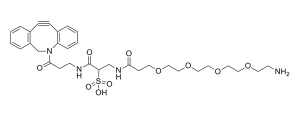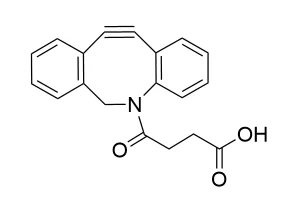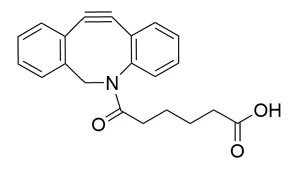Vector Laboratories is closed for the President’s Day on Monday, February 19th. We will be back in the office on Tuesday, February 20th.
We will respond to emails upon our return. Have a wonderful day.
Menu
Vector Laboratories is closed for the President’s Day on Monday, February 19th. We will be back in the office on Tuesday, February 20th.
We will respond to emails upon our return. Have a wonderful day.
DBCO-amine, product number QBD-11750, is an aza-dibenzocyclooctyne (DBCO) product used for strain-promoted azide-alkyne cycloaddition (SPAAC, also known as “”copper free click chemistry””). The DBCO moiety reacts selectively with azides via SPAAC to form stable triazole linkages. The amine terminus of the molecule reacts with carboxylic acids and their active esters to form stable amide bonds. Insoluble in water, DBCO-amine is slightly soluble to sparingly soluble in most organic solvents. Vector Laboratories recommends dimethylsulfoxide (DMSO), N,N’-dimethylformamide (DMF), or N,N’-dimethylacetamide (DMAC) as solvents for this product. DBCO-amine is relatively insensitive to bases and can be used in the presence of aqueous bases. This product is acid sensitive. It should not be subjected to pH <5 during reaction or workup. The product should always be stored at -20°C when not in use.
The published discovery in 2004 of SPAAC, also known as “”copper free click chemistry,”” by Carolyn Bertozzi and coworkers improved the click chemistry toolbox. Toxic copper catalysts were eliminated, making the reaction truly bioorthogonal. By removing the copper(I) catalyst from the reaction, living cells can be labeled with reagents designed for SPAAC. Since the original publication, multiple improvements in strained cyclooctyne reagents resulted in the development of DBCO as a nearly perfect azide partner for SPAAC.
To use DBCO-amine effectively in aqueous media or in cells, it should be conjugated to a water-soluble dPEG® product. Vector Laboratories offers numerous products for this purpose, including hydroxy acids (and their active esters), and protected amino acids. We also offer many DBCO-based dPEG® products already prepared for use.
| Unit Size | 100 mg, 1000 mg |
|---|---|
| Molecular Weight | 276.33; single compound |
| Chemical formula | C₁₈H₁₆N₂O |
| CAS | N/A |
| Purity | > 97% |
| Spacers | N/A |
| Shipping | Ambient |
| Typical solubility properties (for additional information contact Customer Support) | Methylene Chloride, Methanol, Acetone, DMSO, or Acetonitrile. |
| Storage and handling | -20°C; Always let come to room temperature before opening; be careful to limit exposure to moisture and restore under an inert atmosphere; stock solutions can be prepared with dry solvent and kept for several days (freeze when not in use). dPEG® pegylation compounds are generally hygroscopic and should be treated as such. This will be less noticeable with liquids, but the solids will become tacky and difficult to manipulate, if care is not taken to minimize air exposure. |
Greg T. Hermanson, Bioconjugate Techniques, 2nd Edition, Elsevier Inc., Burlington, MA 01803, April, 2008 (ISBN-13: 978-0-12-370501-3; ISBN-10: 0-12-370501-0). Specifically see pp. 726-729 in his Chapter 18 on discrete PEG compounds for pegylation applications.
Greg T. Hermanson, Bioconjugate Techniques, 3rd Edition, Elsevier, Waltham, MA 02451, 2013, ISBN 978-0-12-382239-0; See chapter 18, Discrete PEG Reagents, pp.787-821, for a full overview of the dPEG® products.
Applicable patents and legal notices are available at legal notices.




Stay in the Loop. Join Our Online Community
Together we breakthroughTM

©Vector Laboratories, Inc. 2024 All Rights Reserved.
How do I Request a Quote?
To request a quote for products: